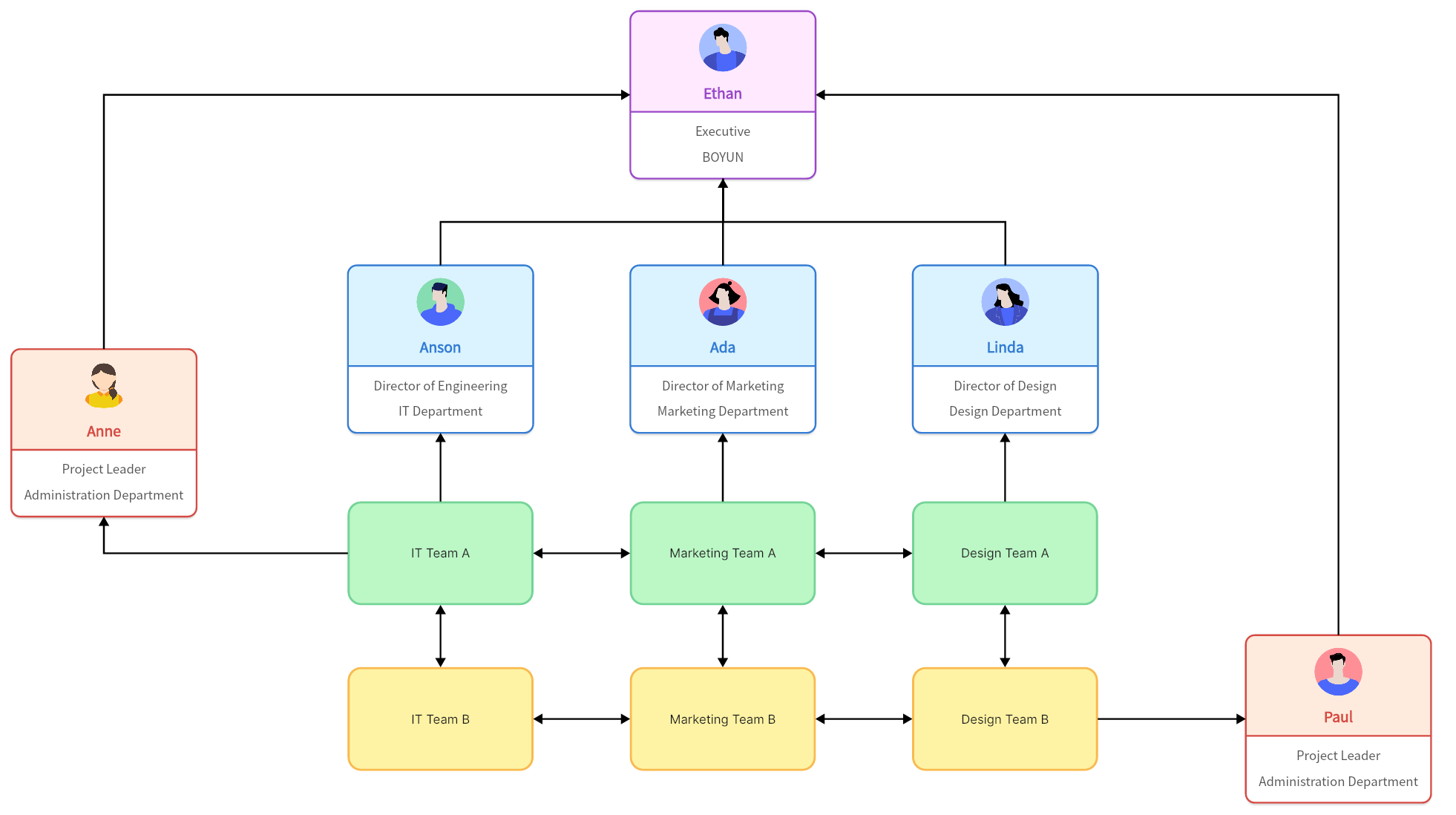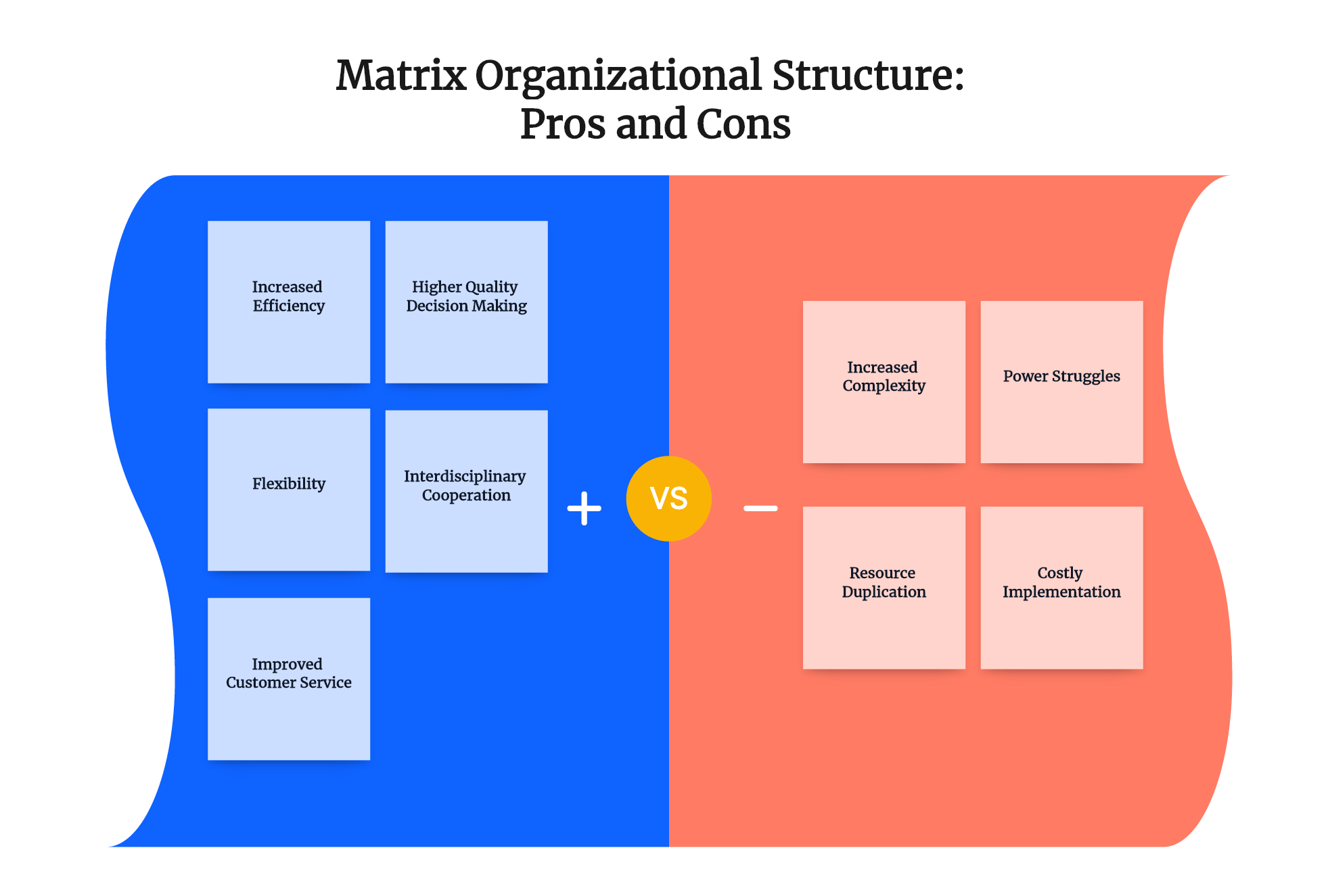In the complex, dynamic world of business, finding the right organizational structure can be pivotal to success. With a myriad of structures to choose from, the matrix organizational structure has proven its worth in many successful corporations. So, what is this structure, and what does it entail? This comprehensive guide uncovers the matrix organizational structure's inner workings, benefits, potential downsides, and examples in different sectors. Furthermore, we've included frequently asked questions to give you a well-rounded understanding of this popular business framework. As we delve into the heart of this structure, you'll discover its unique blend of hierarchy and flexibility – a balance that has been instrumental to the prosperity of numerous businesses worldwide. Are you ready to discover if the matrix structure could be the key to your business's success? Let's embark on this journey of organizational exploration together.
What is the Matrix Organizational Structure?
The matrix organizational structure, a hybrid structure, stands out due to its dual managerial system. This structure meshes two critical components - a product or project-based department and a functional department - into one seamless entity. Each employee within this structure has two bosses: the functional manager who oversees their area of expertise and the project or product manager who directs their work on specific projects.
Born out of the intense competition and accelerated advancements of the 1960s space race, the matrix organizational structure was first implemented by aerospace manufacturers in the U.S. The aim was to maximise resources, expertise, and performance within rigid timelines. Over time, many other industries recognized the unique advantages of this structure and adopted it for their business models.
The matrix organizational structure’s dual focus on product (or project) and function offers a nuanced approach to management. It integrates diverse elements of an organization, such as people, resources, and operational aspects, fostering enhanced communication, innovation, and adaptability.

How Does a Matrix Organizational Structure Work?
In a matrix organizational structure, each employee's role is dual-faceted. One aspect is functional - tied to a specific department or division like Marketing, Sales, or HR - where their role aligns with their core skills or area of expertise. The functional manager oversees these duties, ensuring performance standards are met and facilitating professional development within that specific area.
On the other hand, employees are also grouped based on various projects or assignments that require collaboration from different departments. These roles are transient, varying according to the organization's needs or projects at any given time. A project manager supervises these roles, providing strategic guidance based on project objectives.
To visualize this, picture an employee working in the Marketing department (the functional role) being assigned to a team tasked with launching a new product (the project role). This individual reports to both the Head of Marketing and the Product Launch Manager.
In essence, the matrix organizational structure encourages resource sharing and open lines of communication across traditional departmental boundaries. This dynamic flow of information promotes more efficient operations, effective use of resources, and successful delivery of projects – while also nurturing cross-functional learning and innovation.
Advantages of Matrix Organizational Structures
The matrix organizational structure, a meld of hierarchical and flexible organizational designs, boasts several unique benefits that contribute to increased business efficiency and productivity.
- Increased Efficiency: A key advantage of a matrix structure is the increase in efficiency. This structure facilitates easy and immediate information sharing across various departments. With the dual reporting system, employees can readily share information across task boundaries, thereby increasing organizational efficiency. An engineer working on a project could quickly relay any design issues to the design team, enabling swift remediation. This quick exchange of information can boost productivity and save crucial time.
- Higher Quality Decision Making: Matrix structures foster participative decision making, resulting in higher quality decisions. This participatory nature allows for an array of inputs and perspectives, promoting a holistic approach to problem-solving. As employees from various functional areas contribute their expertise to a common project, they bring diverse ideas and viewpoints to the table. This richness can lead to more innovative solutions and more robust decision-making processes.
- Flexibility: In an ever-changing business landscape, the ability to adapt is crucial. The matrix structure, with its dual-focus, provides this flexibility. As an organization's needs change, so can the focus of its projects and teams. This adaptability can be instrumental in helping businesses navigate and thrive in uncertain conditions or market shifts.
- Interdisciplinary Cooperation: The matrix structure's unique design promotes interdisciplinary cooperation. It breaks down departmental silos and encourages employees from different functional areas to work together towards common project goals. This cross-collaboration leads to knowledge sharing and learning, sparking innovation.
- Improved Customer Service: Teams within a matrix organization can respond quickly and effectively to customer demands due to their interdisciplinary nature. For instance, in a product launch, the collective expertise of team members from marketing, design, production, and distribution can help address any customer concerns promptly and effectively.
Disadvantages of Matrix Organizational Structures
While the matrix organizational structure brings many benefits, it's not without drawbacks. Its unique configuration can introduce challenges that may hamper its effectiveness in certain settings:
- Increased Complexity: One of the major challenges of a matrix structure is increased complexity due to dual reporting lines. Employees report to both a functional manager and a project manager, which can lead to confusion and ambiguity. It might be unclear whose instructions to prioritize when directives from the two managers conflict. This uncertainty could potentially delay decision-making processes and impede project execution.
- Power Struggles: The presence of two bosses may create power struggles within the organization. Both the functional manager and the project manager may vie for authority over employees, potentially leading to discord and disagreements. These conflicts, known as "turf wars," can negatively impact team morale and productivity if not appropriately managed.
- Resource Duplication: The matrix structure might inadvertently result in resource duplication due to a lack of coordination. For instance, two different project teams might independently procure similar resources for their projects, resulting in unnecessary expenditures and wastage.
- Costly Implementation: Implementing a matrix structure isn't a trivial task—it involves substantial changes to conventional hierarchical systems and requires considerable time and financial investment. Training staff to operate effectively within this new structure, clarifying roles, and instilling new work cultures can prove costly.
Furthermore, while larger corporations may benefit from the matrix's structured flexibility, smaller businesses or startups might find it cumbersome. In such environments where simplicity and swift decision-making are key, the complexities of a matrix structure could stifle agility and responsiveness. Thus, these businesses may be better served by simpler organizational models that facilitate faster decisions and more direct lines of communication.

Tips for Using the Matrix Organizational Structure
Implementing a matrix organizational structure can be a transformative process, enabling more dynamic collaboration and enhanced productivity. However, to unlock its full potential, it is crucial to apply it with careful planning and strategic foresight. Here are several tips to successfully utilize a matrix structure:
- Define Clear Roles and Responsibilities: To avoid confusion and conflicting directives, it is essential to clarify each individual's roles and responsibilities within the matrix. Both functional and project managers should have a clear understanding of their specific duties and their interdependencies with others in the organization.
- Promote Open Communication: The matrix structure thrives on efficient communication. Encourage open dialogues between different managers and departments to foster collaboration and prevent miscommunications that could disrupt operations.
- Invest in Training: With its complexity, employees may require training to understand the nuances of the matrix structure fully. This training should emphasize not only the structure's mechanics but also its advantages and challenges, preparing employees for potential issues they might encounter.
- Manage Conflicts Effectively: In a matrix structure, power struggles and "turf wars" can arise between functional and project managers. Having effective conflict management strategies in place can ensure these conflicts are resolved swiftly, preserving team morale.
- Ensure Leadership Support: Implementing a matrix structure often involves considerable changes to traditional hierarchies. Without strong support from leadership, this transition could face resistance from staff accustomed to conventional structures.
- Monitor and Adjust: Like any other organizational structure, it's crucial to continually monitor the matrix system's effectiveness and make necessary adjustments. Regular check-ins can help identify pain points and opportunities for improvement.
Examples of Matrix Organizational Structure in Different Sectors
The matrix organizational structure is not exclusive to any one sector; its application transcends industry boundaries, with various sectors employing it to drive efficiency and foster cross-functional cooperation. Numerous renowned organizations from different fields have successfully harnessed the benefits of this unique structure. Let's delve into how different sectors have capitalized on the matrix organizational structure by looking at specific examples:
Aerospace Industry: Lockheed Martin
In the aerospace industry, Lockheed Martin stands out as a key example. Known as one of the largest aerospace, defense, and technology companies worldwide, Lockheed Martin can be credited as one of the early adopters of the matrix structure. Their introduction of this structure dates back to the late 1960s, where it was applied to their esteemed Skunk Works projects. The success achieved on these high-profile projects underscored the potential of the matrix system in enabling robust project management and facilitating cross-functional collaboration.
Technology Sector: Hewlett-Packard (HP)
The technology sector, known for its dynamic environment, also showcases successful implementation of the matrix structure. A prime example is tech giant Hewlett-Packard (HP). HP adopted a matrix structure to manage their sprawling global operations effectively. This system allowed them to maintain a balanced focus on two significant aspects—product categories and geographic regions. HP's leaders held the belief that this dual emphasis would lead to optimized resource use and enhanced communication across various business domains.
Consumer Goods Industry: Unilever
In the consumer goods sector, Unilever—a leading company boasting a vast portfolio of brands—provides a case study for the matrix structure's application. Unilever's adoption of this structure ensures effective management of their diverse operations. The matrix system allows Unilever to coordinate their broad range of product lines across numerous global markets, thereby ensuring streamlined communication and aligned strategies.
Oil & Gas Industry: Royal Dutch Shell
Shell, a global conglomerate of energy and petrochemical companies, represents the successful utilization of a matrix structure within the oil and gas industry. By organizing their operations based on both business lines (upstream, integrated gas, downstream, and projects & technology) and geographic markets, Shell ensures efficient resource allocation and fosters better decision-making processes.
Frequently Asked Questions about Matrix Organizational Structures
Are There Any Alternatives to a Matrix Organizational Structure?
Indeed, there are several other forms of organizational structure that businesses can adopt, depending on their specific needs and contexts. These include the Hierarchical structure, Functional structure, Divisional structure, Network structure, and Team-based structure. Each presents its unique advantages and challenges. For a more in-depth exploration of different organizational structures, consider reading "8 Types of Organizational Structures for Businesses."
What Industries Commonly Use the Matrix Organizational Structure?
Industries with complex operations and projects – such as healthcare, construction, IT, or consulting – commonly implement matrix structures. They enable these organizations to address dynamic project needs while also focusing on functional expertise.
How Can You Resolve Conflicts in a Matrix Organizational Structure?
Conflicts are likely to occur in a matrix setting due to dual reporting. However, organizations can alleviate these through clear role and responsibility delineation, fostering a culture of open communication, and ensuring that managers foster trust and collaboration.








